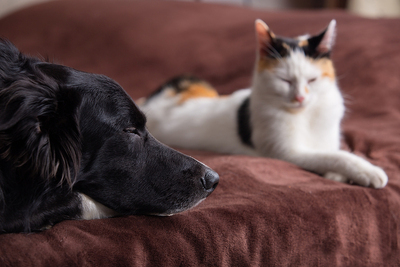Flea Allergy Dermatitis in Dogs and Cats
What is Flea Allergy Dermatitis?
Flea Allergic Dermatitis (FAD) is an allergic reaction where the animal is sensitive to being bitten by a flea and the flea's saliva, which results in severe skin irritation and inflammation. It is among the most common skin allergies found in dogs but is also becoming more common in cats.
What happens to the body?
When a flea bites an animal, they inject a tiny bit of saliva back into the skin, which has anticoagulant properties, stopping the blood from coagulating so the flea can get a non-stop blood feed. However, the protein within this saliva causes an allergic reaction. Fifteen antigens are present within the flea saliva. Anyone of these is capable of causing this reaction in our pets.
Since these animals are hypersensitive to flea saliva, it may only take one or two flea bites to produce such a severe reaction, that can last for weeks. However, a reaction can take up to 7 days to manifest from the original bite, so often, the owner will look at their pet and say, "but they don't have fleas".
What are the signs and symptoms?
Animals with flea allergic dermatitis are mainly affected on the back at the base of the tail and down the tail. But irritation may also be seen on the back of the legs and the belly. There will be a lot of biting, nibbling, licking and scratching in these areas. The animal may appear to be overgrooming. The hair will start to thin, become dry, and brittle, breaking off or falling out altogether. The skin will appear red and inflamed with pimple-like eruptions; when the animal scratches and breaks the skin, it will form scabs and crust over. Scratching and self-mutilation can lead to secondary skin infections such as hot spots, bacterial pyodermas, folliculitis and, for a cat, miliary eczema.
These symptoms can become an all-year-round problem, but the worse times are in the peak flea periods and breeding seasons of Spring and Summer.
What can you do to help?
Keeping your pet flea free is a top priority. Regularly treating for fleas and also trying to break the life cycle by washing bedding and vacuuming areas where the animal sleeps to get rid of eggs and larvae. Check out our article about Fleas in Cats and Dogs.
Allergies are immune-based. Therefore, keeping your pet in top health with a well-supported immune system will help lessen the reaction's severity, which can be done by a good healthy diet and boosting the immune system using herbs, homeopathy and supplements such as fish oils. Also, keep your pet happy and stress-free.
What can you do Naturally to help?
Here at Natural Pet, in our Tagiwig range, we have many remedies that can help to support your pet's immune response when they are suffering from flea allergic dermatitis.
FAD – Flea Allergic Dermatitis, our main homeopathic blend to assist with FAD
Jumpies (Hom) and Jumpies to assist with keeping your pets flea free. A natural alternative flea product.
Immune Tonic to support and boost their immune system.
Liver Tonic (Hom) and Liver Tonic support and cleanse the liver. A must for any animal that has had commercial flea treatments.
Recent Articles

20% Off
All Cat Remedies
Lorem Ipsum is simply dummy text of the printing and typesetting industry. Lorem Ipsum has been the industry's standard dummy text ever since the 1500s, when an unknown printer took a galley of type and scrambled it to make a type specimen book. Lorem ipsum dolor sit amet, consectetur adipiscing elit. Vivamus leo ante, consectetur sit amet vulputate vel, dapibus sit amet lectus.



 Earn loyalty points everytime you shop
Earn loyalty points everytime you shop

